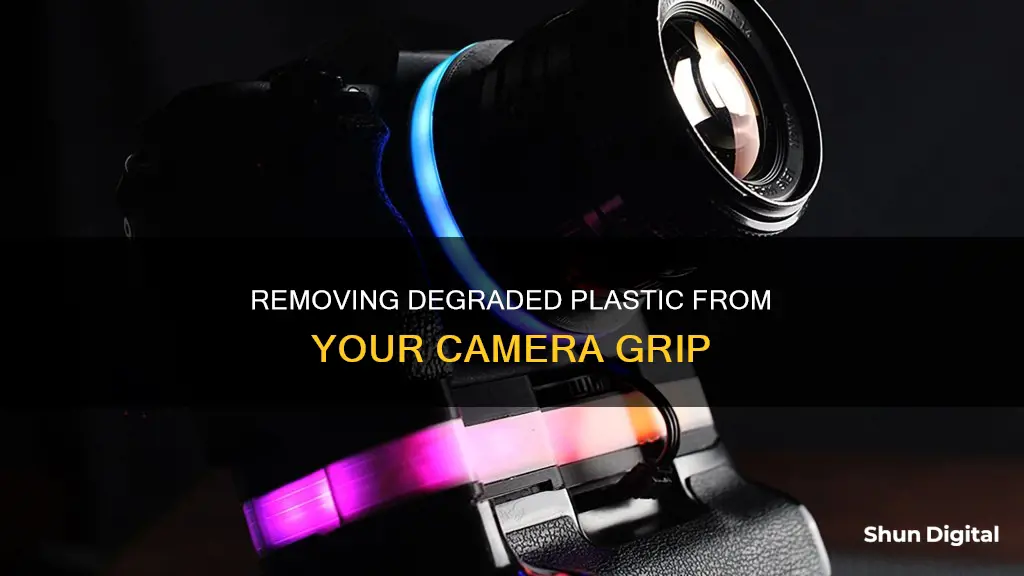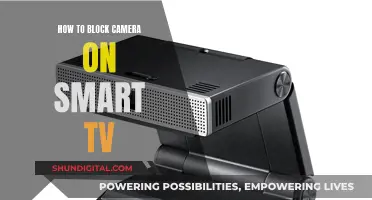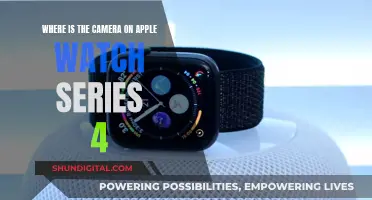
If the rubber grip on your camera has degraded, you can try to restore it by cleaning it with a toothbrush and some soapy water. If this doesn't work, you can try using a small amount of isopropyl alcohol on a cloth to remove the sticky residue. Be careful not to use too much alcohol, as it could damage the camera's electronics. You could also try using acetone, but this should be a last resort as it can be harmful to plastics. If you don't want to remove the rubber grip, you can try to prevent further degradation by keeping the camera in a cool, dry place with good ventilation and low humidity.
| Characteristics | Values |
|---|---|
| Removal methods | Isopropyl alcohol, methylated spirits, denatured alcohol, acetone, Goo Gone, Cif kitchen cleaner, baby wipes, brake fluid, soap and water, talcum powder, citrus oil-based cleaner, leather conditioner, mild soap solution, 303 aerospace protectant |
| Prevention methods | Keep the surface of the rubber clean, store the camera in a cool, dry place with good ventilation, use the camera often, avoid UV light exposure, avoid chemicals and acidic fumes |
What You'll Learn

Use isopropyl alcohol to remove the degraded rubber coating
If you want to remove the degraded rubber coating from your camera grip, you can use isopropyl alcohol. This method is effective for removing thin rubber coatings that have become sticky. Here is a step-by-step guide on how to do it:
Step 1: Prepare the Workspace
- Ensure you are working in a clean area.
- Cover your workspace with a cloth.
- Have spare cloths on hand to remove excess chemicals.
- It is recommended to wear rubber gloves and safety glasses as isopropyl can be absorbed into the skin and may cause poisoning in large amounts.
Step 2: Apply Isopropyl Alcohol
- Place your camera on a clean surface.
- Apply isopropyl alcohol to the affected area, using enough to cover the rubber.
- Be careful not to get the isopropyl alcohol into any electronic areas, such as switches or small openings.
Step 3: Wipe the Rubber
- Start wiping the rubber with a clean cloth. The amount of force required depends on how stubborn the rubber is.
- As isopropyl alcohol evaporates quickly, you will likely need to reapply it a few times.
- Keep re-applying and rubbing with a clean section of the cloth until all the rubber has been removed.
Step 4: Finish Up
- Once all the rubber has been removed, give the camera a final wipe with a clean cloth.
- Power up your camera to ensure it still works properly.
Using isopropyl alcohol is an effective way to remove the degraded rubber coating from your camera grip. Just be cautious and follow the necessary safety precautions.
Displaying a Wireless Camera Feed on Your TV
You may want to see also

Wash with dish soap and a brush
To remove degraded plastic on a camera grip, one method is to wash the grip with dish soap and a brush. Here is a detailed, step-by-step guide on how to do this:
First, ensure you have the right tools and preparations in place. Gather a brush with soft bristles, some dish soap, and a bowl of water. It is also recommended to place a cloth on your workspace and have some spare cloths handy to remove any excess soap or water. Additionally, consider wearing rubber gloves and safety glasses for protection.
Next, start by brushing the camera grip gently with the soft-bristled brush to remove any dust, dirt, or debris. You can also use a slightly damp cloth for this step if preferred. Be careful not to apply too much pressure to avoid scratching the surface.
Once the grip is free of dust and dirt, dip the brush into the dish soap and create a lather in your hand or a small container. Apply the soapy brush directly to the camera grip, gently scrubbing the surface. Ensure that you work the soap into the textured areas of the grip, as dirt and oils can become embedded in these areas over time.
After thoroughly scrubbing the grip, use a damp cloth to wipe away the soap and any remaining dirt or debris. Again, be gentle and avoid applying too much pressure to the grip. You may need to use multiple cloths or rinse and wring out your cloth multiple times to ensure all the soap is removed.
Finally, dry the camera grip thoroughly with a clean, dry cloth. Ensure that no water droplets are left on the camera, as this could potentially damage the internal electronics. You can also leave the camera to air dry in a well-ventilated area if preferred.
This method of using dish soap and a brush is an effective way to deep clean your camera grip and remove any degraded plastic, dirt, oils, or sticky residue. It is important to be gentle and avoid using excessive water to prevent any potential damage to your camera. Always ensure your camera is powered off and the battery is removed before attempting any cleaning methods.
Unboxing Your Akaso Camera: A Step-by-Step Guide
You may want to see also

Use acetone to scrub the sticky rubber coating
To remove degraded plastic on a camera grip, you can use acetone to scrub the sticky rubber coating. Here are the steps you can follow:
Prepare Your Workspace:
- Cover your work area with a cloth.
- Ensure your workspace is clean and well-ventilated.
- Have spare cloths handy to wipe away excess chemicals.
- Wear rubber gloves and safety glasses for protection.
Gather Your Materials:
- Obtain acetone, also known as nail polish remover.
- Prepare a clean cloth or cotton balls/pads for application.
Apply Acetone to the Affected Area:
- Place your camera on a clean surface.
- Moisten a cloth or cotton pad with acetone.
- Apply the acetone to the sticky rubber coating on your camera grip.
- Be careful to avoid getting acetone on electronic components, switches, or small openings.
Scrub the Coating:
- Begin scrubbing the sticky rubber coating with the cloth.
- Re-apply acetone as needed to keep the area moistened.
- Use a clean section of the cloth each time you re-apply acetone.
- Scrub until the rubber coating is removed, revealing the bare plastic underneath.
Finalize the Process:
- Give the treated area a final wipe with a clean cloth.
- Ensure that your camera is powered off and allow it to dry completely.
- Test your camera to make sure it still functions properly.
It is important to note that acetone is a powerful solvent, so use caution and avoid prolonged skin contact or inhalation. Additionally, always test on a small area first to ensure it does not damage the plastic of your camera grip.
Removing Arempji from Your Camera App: A Step-by-Step Guide
You may want to see also

Use a toothbrush and soapy water
To remove degraded plastic on a camera grip, one method is to use a toothbrush and soapy water. This is a safe and simple method that can be effective in removing the degraded plastic and restoring the camera grip to its original condition. Here is a step-by-step guide on how to use this method:
Step 1: Gather Your Materials
You will need a toothbrush, dish soap, and water. It is recommended to use a soft-bristled toothbrush to avoid scratching the surface of the camera grip.
Step 2: Prepare the Cleaning Solution
Mix a small amount of dish soap with warm water. The soapy water will help to break down the degraded plastic and make it easier to remove. Soak the toothbrush in the soapy water to ensure that the bristles are thoroughly coated.
Step 3: Start Brushing
Gently brush the camera grip with the toothbrush, using circular motions. Be careful not to apply too much pressure, as you do not want to damage the surface of the grip. Work in small sections and pay close attention to the areas where the plastic is most degraded.
Step 4: Rinse and Repeat
After brushing, rinse the toothbrush with clean water to remove any soap residue and degraded plastic. Repeat the brushing process as needed until the camera grip is completely free of degraded plastic.
Step 5: Dry the Grip
Once you have finished brushing and rinsing, use a clean, dry cloth to gently wipe down the camera grip. This will remove any remaining soap residue and help to prevent water spots from forming. Ensure that the camera grip is completely dry before using the camera again.
Using a toothbrush and soapy water is a gentle and effective way to remove degraded plastic from a camera grip. It is important to be patient and thorough during the process to ensure that all the degraded plastic is removed. With this method, you can restore your camera grip to its original condition and improve the overall appearance and functionality of your camera.
Removing Your Nest Camera: A Step-by-Step Guide
You may want to see also

Apply a conditioner recommended for that type of rubber
To remove degraded plastic on a camera grip, you can apply a conditioner that is recommended for that type of rubber. This will help to restore the rubber's original condition and prevent further degradation. Here is a step-by-step guide on how to do this:
First, you need to identify the type of rubber used in your camera grip. Different types of rubber may require specific types of conditioners. You can refer to your camera's manual or seek advice from camera experts to determine the suitable conditioner.
Once you have identified the type of rubber, you can purchase a conditioner designed specifically for that type. There are various rubber conditioners available on the market, including those designed for camera equipment. You can find these products online or at specialty camera stores.
Before applying the conditioner, ensure that the camera grip is clean and free from any dirt, dust, or debris. Use a soft, damp cloth to gently wipe down the rubber grip, removing any residues or contaminants that may affect the absorption of the conditioner.
Now, carefully apply the conditioner to the rubber grip following the instructions on the product. Some conditioners may need to be sprayed on, while others may require a gentle rub-on application. Ensure that you are in a well-ventilated area and wear protective gloves if necessary.
After applying the conditioner, allow it to absorb and dry completely. This may take some time, so be patient and follow the instructions on the product for the best results.
Finally, once the conditioner has dried, you can gently buff the rubber grip with a soft cloth to restore its shine and original texture. Your camera grip should now feel refreshed and less degraded.
Remember that while applying a conditioner can help improve the condition of the rubber grip, it may not fully restore it to its original state, especially if the degradation is severe. Regular maintenance and care are essential to prevent rubber degradation and prolong the life of your camera equipment.
Finding the Camera on Your Samsung 4K TV
You may want to see also
Frequently asked questions
To remove degraded plastic on a camera grip, you can use a product like isopropyl alcohol, which can be found in most pharmacies. Apply the solution to a cloth and rub the affected area until the plastic comes off. Be careful not to let the solution drip into the camera's joints or openings.
Isopropyl alcohol is flammable and can be absorbed into the skin in large amounts, so it is important to wear gloves and work in a well-ventilated area when using this product.
Yes, some other products that can be used to remove degraded plastic on camera grips include methylated spirits, denatured alcohol, acetone, and goo gone. However, it is important to note that some of these products may be more damaging to plastics than others.
To prevent your camera grip from degrading, it is recommended to keep the surface clean, avoid exposure to high temperatures and humidity, and store your camera in a well-ventilated area away from harmful vapors and direct sunlight.
Some signs of a degrading camera grip include stickiness, discolouration, and a white powdery substance forming on the surface. If you notice any of these issues, it is important to take action to prevent further degradation and replace the grip if necessary.







